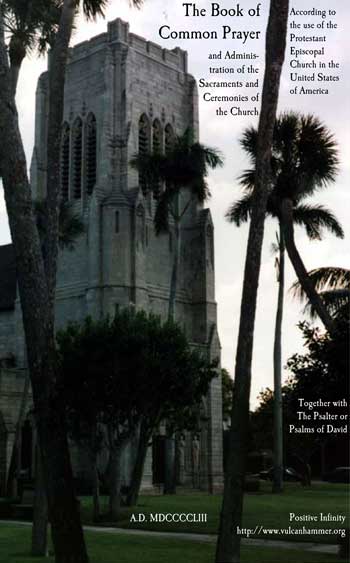Positive Infinity is pleased to present the 1928 Book of Common Prayer, an ostensibly dry and formal book which found itself at the centre of controversy.
The 1928 Book of Common Prayer was the Protestant Episcopal Church’s third prayer book (the first two were in 1789 and 1892.) At the time it was considered an extensive revision, but as it happened it was the Episcopal Church’s last truly “Anglican” prayer book. The introduction of its replacement (heralded by the aptly named “trial liturgies” in 1971) created an uproar; adherence to it became a “litmus test” for a true conservative, and still is for many. The church’s hierarchy, in typical style, went ahead and replaced it with the 1979 book.

Want a copy in print? For economical and nice prayer books for pew and person, we order from Deus Publications and can recommend the same.
Significance to Non-Anglicans
Its importance to traditional Anglicans in the U.S. is self-evident, but it has significance to non-Anglicans as well:
- It is an important and influential piece of English prose, in a similar form as it was with the Church of England. (For the English 1662 Book of Common Prayer, click here.)
- It contains the Thirty Nine Articles, the core doctrines of Anglican Christianity. Reformed theologians (who have an inordinate amount of influence in evangelical Christianity, even in Arminian circles) emphasise the Augsburg and Westminster Confessions, but the Articles are superior to both.
- It contains the “Episcopal” ceremony of matrimony, which (along with countless variants) has united couples of many denominations over the years.
- It has a detailed “schedule” of the liturgical year, unfamiliar to many Christians, including methods of calculating Easter (one of my mother’s favourite features!) We feature a script that allows this calendar to be announced on your website; click here to download.)
Download the 1928 Book of Common Prayer
About this Edition
This Adobe Acrobat edition was prepared by Charles Wohlers. The 1928 book was designed so that every prayer book would have the same pagination and page layout (as is the case with the Book of Mormon.) Reproducing this electronically is a real feat, with the fonts and other obstacles. Wohlers’ achievement is thus remarkable.
Some Personal Reflections
Growing up in the Episcopal Church, I always thought of the liturgy as antiquated. Part of the problem was that my home church was “high church” in the extreme, which accentuated that feeling. When the prayer book controversy hit, I was a little mystified at the significance of the whole thing.
But it wasn’t of much import by that time, as I was in the process of converting to Roman Catholicism. Doctrinal problems set aside (and these are important,) in my view what the Episcopalians came up with in 1979 could not tie the shoes of the “Novus Ordo Missae” that the Catholics were just starting with. To tell the truth, the 1979 book couldn’t tie its own shoes either!
The prayer book controversies, however, are an illustration of one of the banes of the English speaking world: debating substantive issues by arguing over documents. Today in the U.S. we debate many issues in our society, not on their merits, but by their constitutionality. The basic problem with the newer prayer book is that many of the people who produced it did not believe some or all of the essentials of the Christian faith, while the older ones, with their difficult prose, were produced by people who did. Recent events are finally focusing everyone on what’s important, and all Christians who believe in the Truth need to support those who are fighting for it.



1928 Book of Common Prayer…there are no page numbers. How are you supposed to find what you are looking for?
LikeLike
That’s something I never noticed before. I did not do the digitisation and layout of this doucment. I did do the layout for the 1662 Book, and there are both page numbers and bookmarks. I will see if a different layout is available.
LikeLike
This website is certainly a fine. I expect I will be a frequent visitor.
LikeLike
Thank You.
I came here via a reference in the novel “Victoria”
LikeLike